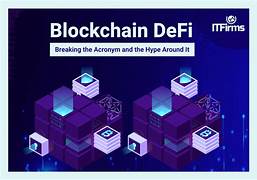What Is the Role of Blockchain Technology in DeFi?
In recent years, the financial industry has experienced a transformative shift, driven by the rise of Decentralized Finance, commonly known as DeFi. DeFi represents a new way of conducting financial transactions, one that operates outside the traditional financial institutions and intermediaries. At the heart of this revolution is blockchain technology, which provides the foundation for secure, transparent, and decentralized systems. Blockchain’s role in DeFi is essential, as it underpins the core principles of decentralization, immutability, and transparency that make DeFi a disruptive force in the financial world.
In this article, we’ll explore the role of blockchain in DeFi, how it enables new financial services, the benefits it brings to users, and the challenges it faces in its adoption.
What is Decentralized Finance (DeFi)?
DeFi is a broad term that refers to a suite of financial services and applications that operate on blockchain networks, with the primary goal of removing the need for centralized intermediaries, such as banks, brokers, and payment processors. Instead, DeFi leverages smart contracts—self-executing contracts with terms written directly into code—that automatically facilitate, verify, and enforce the execution of financial agreements.
DeFi applications, or dApps (decentralized applications), are built on public blockchains, such as Ethereum, Binance Smart Chain, and others. These applications aim to provide traditional financial services like lending, borrowing, trading, insurance, and savings in a decentralized and trustless environment. Blockchain technology enables these services to function without relying on traditional financial institutions, reducing the need for third-party trust, lowering costs, and enhancing accessibility.
Blockchain’s Role in DeFi
Blockchain technology is the cornerstone of DeFi. Without blockchain, it would be impossible to achieve the decentralized and transparent nature that defines DeFi applications. Here’s a closer look at the key ways blockchain facilitates DeFi:
1. Decentralization and Security
At its core, blockchain is a decentralized ledger that is distributed across a network of computers (nodes). This decentralization eliminates the need for a central authority or intermediary to manage transactions and financial records. For DeFi, decentralization is crucial because it ensures that no single entity has control over the financial services or data. This feature aligns with the fundamental principle of DeFi, which is to empower individuals to take control of their financial activities.
Blockchain’s decentralized nature also enhances security. Since the data is stored across a distributed network of nodes, it is difficult for a hacker to compromise the entire system. Additionally, blockchain uses advanced cryptographic techniques to secure transactions, making it nearly impossible for anyone to alter or tamper with the data once it has been recorded.
2. Immutability and Transparency
One of the standout features of blockchain is immutability. Once a transaction or contract is added to the blockchain, it cannot be altered or deleted. This ensures the integrity of the financial data, providing a transparent record that is accessible to all participants in the network. Immutability plays a critical role in building trust in DeFi systems, as users can be assured that their transactions are securely recorded and cannot be changed.
Transparency is another key benefit of blockchain technology in DeFi. All transactions on the blockchain are publicly available and can be audited by anyone at any time. This transparency fosters trust among users, as they can independently verify the information and performance of smart contracts, financial services, and protocols. It also reduces the risk of fraud and manipulation since all activities are recorded in a public ledger.
3. Smart Contracts and Automation
Smart contracts are self-executing contracts where the terms of the agreement are written directly into code. When certain conditions are met, the contract automatically executes the specified actions, without the need for intermediaries. Blockchain platforms like Ethereum are known for supporting smart contracts, making them integral to the operation of DeFi applications.
Smart contracts enable DeFi applications to automate a wide range of financial services, such as lending, borrowing, trading, and insurance. For example, in a decentralized lending platform, users can lend their assets to others, and the smart contract automatically facilitates the loan by transferring assets to the borrower and ensuring that repayment occurs according to the agreed-upon terms. This automation reduces human error and minimizes the need for intermediaries, making financial transactions faster, cheaper, and more efficient.
4. Tokenization and Asset Management
Blockchain technology allows for the creation of digital tokens that represent real-world assets, such as stocks, bonds, or real estate. These tokens can be easily traded, transferred, and managed on blockchain networks, enabling new forms of financial products in DeFi. Tokenization in DeFi opens up opportunities for fractional ownership, where users can own portions of expensive assets, such as high-end real estate or rare collectibles, without the need for large capital investments.
Moreover, tokenization allows for more efficient asset management, as digital tokens can be easily transferred, tracked, and exchanged on decentralized exchanges (DEXs). This capability has led to the development of innovative financial products in DeFi, such as liquidity pools, yield farming, and synthetic assets, which allow users to generate returns on their holdings by participating in decentralized markets.
5. Decentralized Exchanges (DEXs)
One of the most notable applications of blockchain in DeFi is decentralized exchanges (DEXs). DEXs are platforms that allow users to trade cryptocurrencies and digital assets directly with each other, without the need for a central authority or intermediary. Instead of relying on a centralized exchange to match buyers and sellers, DEXs use smart contracts to facilitate peer-to-peer trading.
Blockchain’s role in DEXs is essential because it enables the secure, transparent, and trustless environment that DEXs rely on. Every trade executed on a DEX is recorded on the blockchain, ensuring that the transaction is secure and transparent. Furthermore, users maintain control of their private keys, which reduces the risk of hacks and theft associated with centralized exchanges.
6. Governance and Community Participation
Blockchain in DeFi also plays a crucial role in governance. Many DeFi projects use decentralized autonomous organizations (DAOs) to allow token holders to participate in the decision-making process. DAOs are governed by smart contracts and enable stakeholders to vote on proposals, such as changes to the protocol, fee structures, or future developments.
This decentralized governance structure ensures that DeFi projects are not controlled by a single entity but rather by the community of users who are invested in the project. Blockchain’s transparency and immutability ensure that the governance process is fair, and all votes and proposals are recorded on the blockchain, providing a clear and auditable trail of decision-making.
Benefits of Blockchain in DeFi
The integration of blockchain technology in DeFi offers several significant benefits to users and the financial ecosystem as a whole:
- Financial Inclusion: Blockchain-enabled DeFi applications are accessible to anyone with an internet connection, regardless of location or financial background. This opens up financial services to unbanked and underbanked populations who may not have access to traditional banking systems.
- Reduced Costs: By eliminating intermediaries and automating financial transactions, DeFi can significantly reduce transaction fees, operational costs, and the time required to process payments or loans.
- Security and Privacy: Blockchain provides a higher level of security compared to traditional financial systems. Transactions are encrypted, and the decentralized nature of the blockchain makes it harder for hackers to compromise the system. Additionally, users retain control over their private keys, ensuring greater privacy and security.
- Increased Transparency: Blockchain’s transparency ensures that all transactions are visible to all participants in the network. This reduces the risk of fraud, manipulation, and errors, and fosters trust among users.
- Innovation and Programmability: The programmability of blockchain through smart contracts enables the creation of novel financial products and services that were previously impossible with traditional finance. This includes automated lending platforms, liquidity mining, synthetic assets, and much more.
Challenges and Risks of Blockchain in DeFi
Despite the promising potential of blockchain in DeFi, there are several challenges and risks that must be addressed for DeFi to reach its full potential:
- Scalability: As the number of users and transactions in DeFi grows, blockchain networks can become congested, leading to slower transaction times and higher fees. Solutions like Ethereum 2.0 and layer-two scaling solutions are being developed to address this issue, but scalability remains a challenge.
- Regulatory Uncertainty: DeFi operates in a largely unregulated environment, and governments and regulatory bodies are still figuring out how to approach DeFi. Regulatory uncertainty can create risks for users and projects, especially if new regulations are introduced that impact DeFi operations.
- Smart Contract Vulnerabilities: While smart contracts are designed to be self-executing and secure, they are still susceptible to coding bugs or vulnerabilities. A poorly written or maliciously designed smart contract can lead to financial losses or exploitation.
- Security Risks: Despite blockchain’s inherent security features, DeFi platforms are still vulnerable to hacks, rug pulls, and other malicious activities. Users need to be cautious about where they invest and the platforms they use.
Conclusion
Blockchain technology is the driving force behind the DeFi movement, providing the infrastructure needed to create decentralized, secure, and transparent financial services. From lending and borrowing to decentralized exchanges and governance, blockchain enables DeFi to offer an innovative alternative to traditional finance. As DeFi continues to grow, blockchain will remain central to its success, enabling greater financial inclusion, lower costs, and improved security.
However, DeFi still faces challenges related to scalability, regulation, and security that need to be addressed before it can reach mainstream adoption. As technology matures and solutions are developed, the role of blockchain in DeFi will only become more pronounced, potentially reshaping the future of finance.


